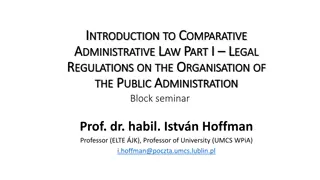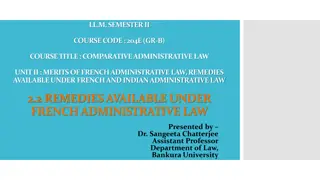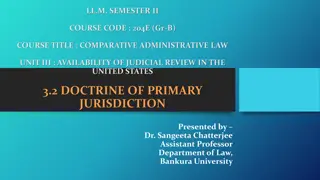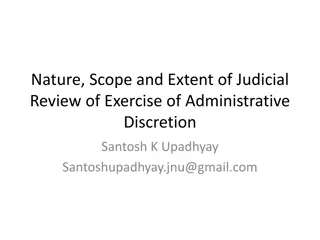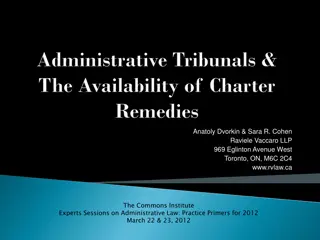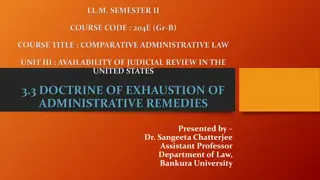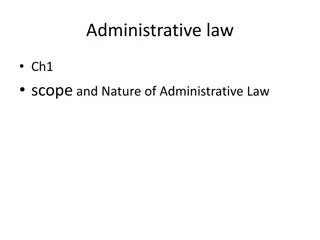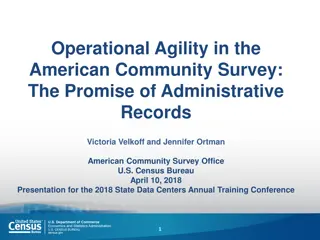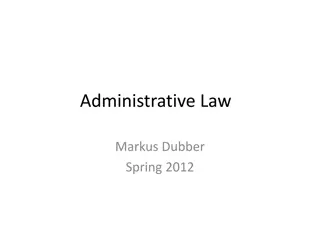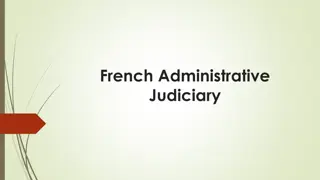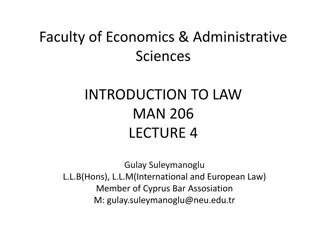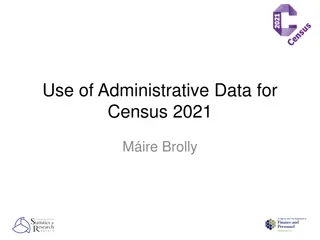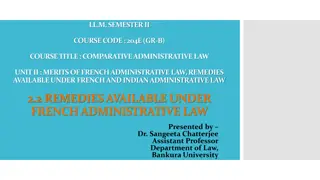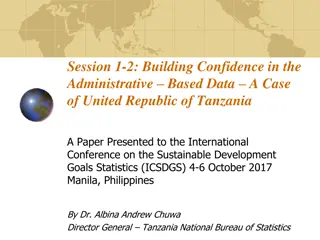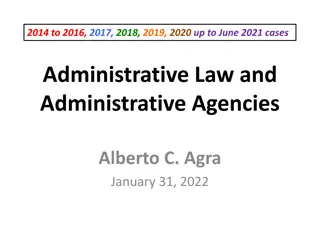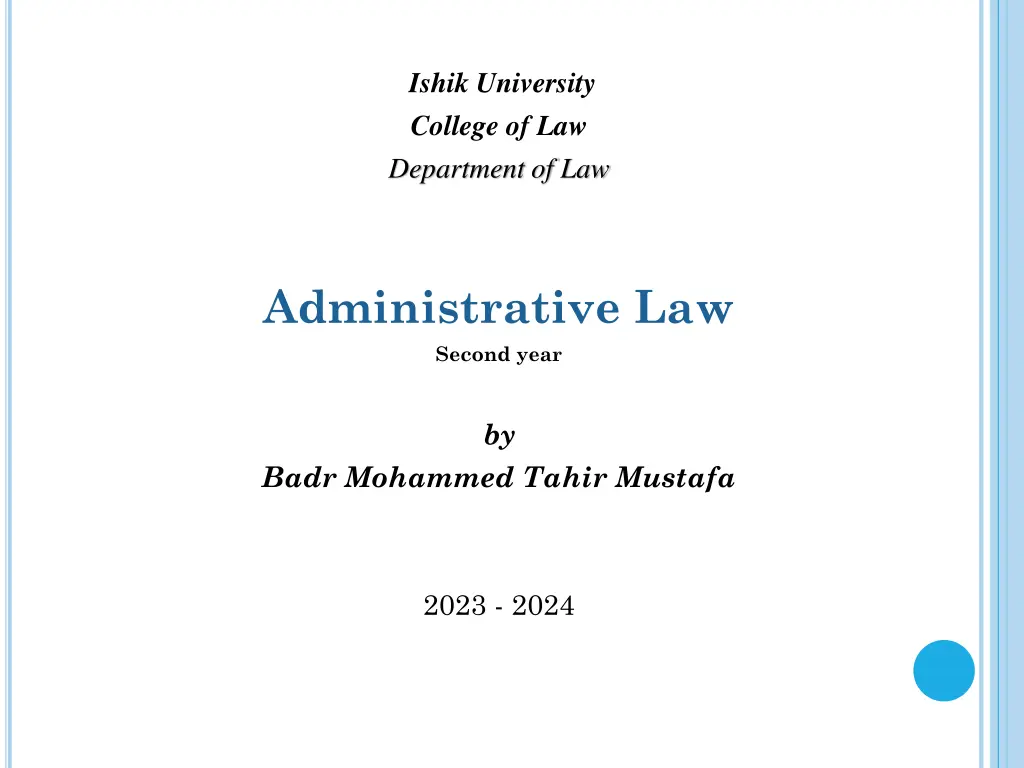
Understanding Administrative Law: Definition, Purpose, and Sources
Explore the concept of administrative law, its definition, purpose, and key sources. Learn how administrative law regulates governmental agencies and ensures the rule of law, individual rights, accountability, and transparency. Discover the role of constitutional law in shaping administrative practices.
Download Presentation

Please find below an Image/Link to download the presentation.
The content on the website is provided AS IS for your information and personal use only. It may not be sold, licensed, or shared on other websites without obtaining consent from the author. If you encounter any issues during the download, it is possible that the publisher has removed the file from their server.
You are allowed to download the files provided on this website for personal or commercial use, subject to the condition that they are used lawfully. All files are the property of their respective owners.
The content on the website is provided AS IS for your information and personal use only. It may not be sold, licensed, or shared on other websites without obtaining consent from the author.
E N D
Presentation Transcript
Ishik University College of Law Department of Law Administrative Law Second year by Badr Mohammed Tahir Mustafa 2023 - 2024 1
THECONCEPTOFADMINISTRATIVELAW Administrative law expanded greatly during the 20th century as legislative bodies worldwide created more governmental agencies to regulate the social, economic and political spheres. Administrative Law is a part of the legal framework for public administration. Public administration is the day-to-day implementation of government policy and it aims at preparing civil servant for 2 working in the public service.
Definition of Administrative Law Administrative Law is the branch of law that regulates the administrative bodies in the state and governs the activities carried out by the administrative agencies to achieve the public interest. This law controls Administrative power. One of its primary purposes is to keep the powers of Administrative bodies within their legal bounds in order to protect the citizens against their abuse. 3
Talk about Purpose of Administrative Law? 1. controlling the manner of exercising public power so as to ensure that rule of law is applied. 2. respecting the rights and liberties of individuals. 3. enhancing accountability and transparency. 4. embodying positive principles to facilitate good administrative practice. In order for the above-mentioned purposes to be achieved, it is necessary to have a governing system rooted in basic principles of rule of law and good administration. 4
SOURCESOF ADMINISTRATIVE LAW Sources of Administrative law can be divided into two categories: The main sources: The secondary sources: A- The main sources: 1. The Constitution: The Constitution is the creator of several administrative bodies and agencies. It briefly sets forth details about mechanisms, procedures and administrative powers granted to various authorities. It contains provisions regulating the manner of government administration, administration regulation and accountability of public bodies. 5
Constitutional law is the branch of the public law of a state which contains: A. The organization, powers, and frame of authorities. B. The distribution of political and governmental authorities. C. The fundamental principles which regulate the relations of government and citizens. D. The fundamental principles which prescribes generally the plan and method of public affairs which must be administered. Article 122 in the Constitution of republic of Iraq in 2005. 6
2. Legislation Laws adopted by parliament, can be considered one of the primary sources of administrative law. The statute creating an agency known as enabling act or parent act, clearly determines the limit of power conferred on the created agency. An administrative action exceeding such limit is an ultra vires, and in most countries the courts will be ready to intervene and invalidate such action. Usually, administrative law provisions are not codified in one legal code due to the continuously developing government activities. However, it can be found in various pieces of legislations.The Law of 7 Governorates No. 3 of 2009 is an example of administrative legislation in the Kurdistan region. Give an example of Administrative Law?
3. Judgments Judgments are the most important source of administrative law and the main historical source of its theories and principles such as the emergency circumstance theory and the administrative responsibility theory. However, when the judge issues an administrative judgment, he/she is not considered as a legislator since the judge practices his/her own task; thus, when there are no applicable obvious written or customary rules, the judge tries to find out a suitable solution as a result, his/her rule deemed as a new administrative law source. The judgment of (Tribunal of Conflicts) about Blanco case in 1873 in France, this judgment created a theory after thirty years from that time. 8
4. Custom Administrative customs represent a consecutive conduct which is followed by public administration during its activities. A custom should be general and practiced by the administration. The custom should not, however, contain any contrary conduct with legal rules. These elements create an obligatory custom. Hence, any such contradicting conduct will be refused and may result in legal punishment. 9
Secondary Sources of AL 1. Delegated Legislation Is a legal instrument issued by executive authority whereby the legislator authorizes a minister to adopt regulations containing technical and other details intended to facilitate the implementation of the statute in question. In another words, the legislative authority delegates the executive authority to take necessary actions. Delegated legislations are used to save parliament time. Article 30 of the Federal Investment Law No 13 of 2006 states that: the Council of Ministers shall adopt regulation in order to facilitate the implementation of this law. 10
2. Jurisprudence Is the views of competent scholars in law including their explanations and interpretations, whether in their books, or research, or lectures. The role of jurist is limited to explain provisions of the law, and to interpret its ambiguity. Therefore, jurisprudence helps lawmaker who amends the law and judges who apply it. 11
Administrative Regulation Centralisation: Centralization (Central Administration) is the process by which the activities of government, particularly those regarding decision-making process, become concentrated within a particular location and a particular group. According to this shape of administration, the central government alone practices the administrative function in the state. 12
There are two types of centralism: 1. Concentrated administration: this means that all authorities of the state are in the hand of the central government without any participation by the officials in the local governments. 2. Non-concentrated administration: under this system, the central government grants partial participations to the regional authorities under its rigid control and supervision. 13
ADVANTAGESOF CENTRALISM 1. It makes the legal and political unity of the state coherent. 2. It leads to uniformity of systems and plans across the country. 3. It reduces co-ordination problems that is, the central government has the authority to order all local governments to act in a specific manner. 14
DISADVANTAGES 1. Since all decisions are made at the highest level of authority, centralisation might result in delays in decision-making and communication. 2. It is not in line with democratic principles. 3. It does not give opportunity to lower bodies to develop their administrative skills. 15
Decentralization Is a system in which the powers and responsibilities are transferred from the central authority to the local authorities. It may contribute to key elements of good governance by increasing people's opportunity for participation in economic, social and political decisions; allowing local and regional governments to manage their own affairs; Enabling local governments to respond to people's needs and 16 priorities.
Therefore, decentralization is consistent with the principles of democracy because powers are shared, citizens can express themselves and participate in governance via their representatives. 17
ADVANTAGESOF DECENTRALIZATION 1. It reduces the workload of the central authorities. 2. It makes decision-making process quicker and more feasible. 3. Local bodies will have sufficient authority to formulate their own policies and procedures. 4. It encourages development of managerial personnel; thus, they can improve their skills. 18
DISADVANTAGESOF DECENTRALIZATION 1. It increases the administrative expenses. 2. It may leads to co-ordination problem among central and local administrations. 3. It leads to prejudice the unity of the state through distribution of administrative functions. 4. Conflict may arise between central and local authority because local authorities often give priority to local interests rather than 19 public interests.
REASONSFORTHE CREATIONOF AGENCIES The following are the main reasons for the creation of administrative agencies: The existence of recognized problems in the society Addressing and tackling the issues which may arise in the course of executing a legislation or even afterwards Providing specificity, protection and services 20
Benefits of E-government: 1. lessening corruption and bureaucracy in administration 2. improving the efficiency of the administrative system 3. increasing transparency 4. revenue growth, and cost reductions. 5. in addition, moving away from a heavily paper-based system to an electronic system this would reduce the need for man-power 21

